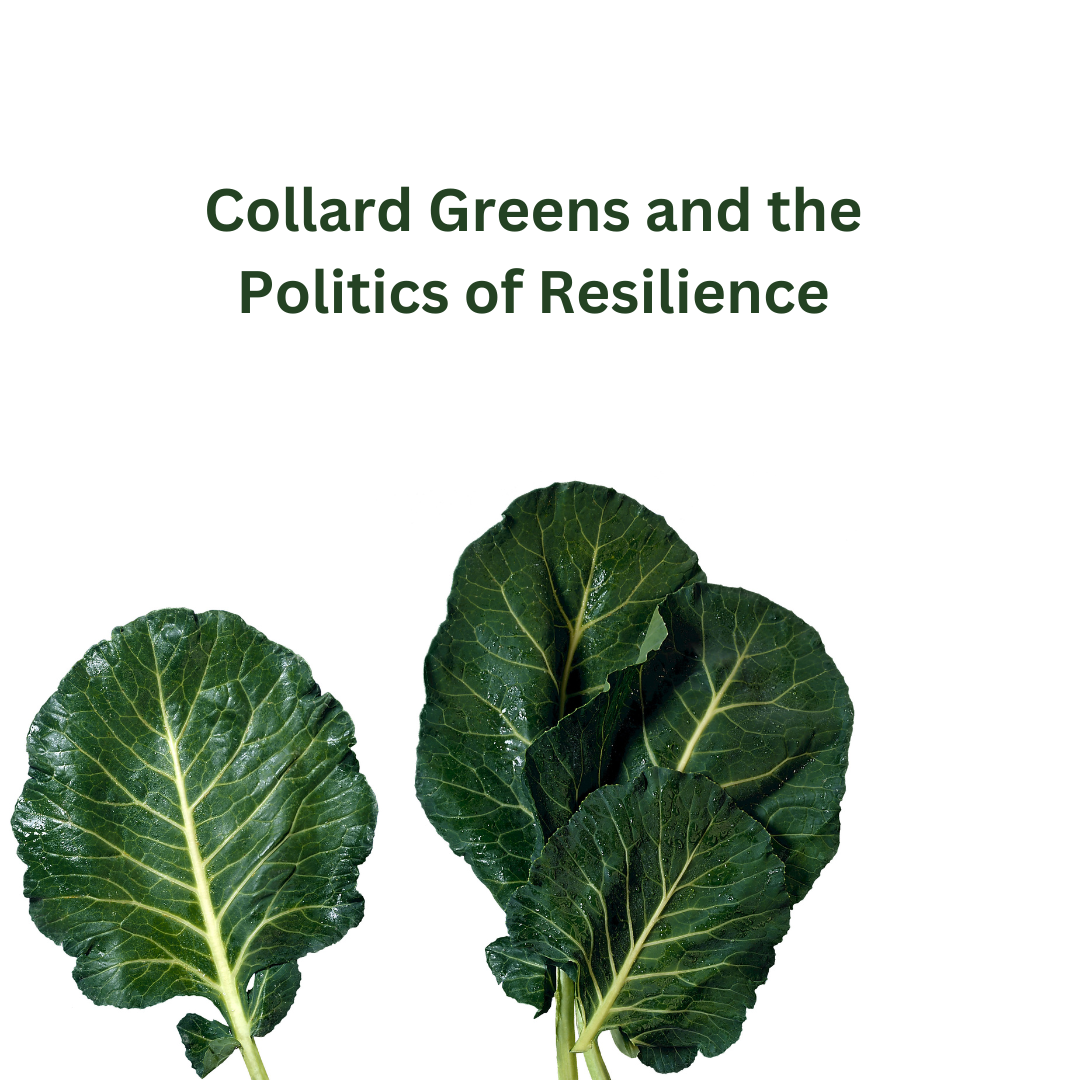Editor’s Note: As an offering to the Riverwise Community, over the next four editions we will feature a special recipe and it’s story from the community inspired kitchen of Josmine Evans, founder of the Detroit based Indigo Culinary Co. We hope you find these offerings that are rooted in critical connections with tradition, history and our present as delicious, comforting and healing as we do!
Winter Greens, Revolutionary Roots: The Story of Collards
In the depths of winter, collard greens stand tall—an unyielding green that has fed generations through struggle and triumph. A staple of African American cuisine, collards tell a story of survival, ingenuity and resistance. In the cultural foodways of the West Africans who were brought across the Atlantic in chains, leafy greens were a staple. However, in a new environment with a more temperate weather, the wildcrafted greens of their homelands were replaced with these cruciferous leaves.
Grown in gardens as an act of self-sufficiency and cooked into pots that often fed many households, collard greens have long been a staple in African American kitchens. During slavery, these greens were cultivated in subsistence plots and transformed into sustaining meals. This practice laid the foundation for what we now call “soul food.” Born out of necessity during the horrors of enslavement, these greens became more than sustenance—they became symbols of resilience and community.
Today, collard greens continue to nourish not just bodies but movements. They’re a reminder of the importance of food sovereignty—of growing, cooking, and eating on our own terms. In Detroit, urban gardens and cooperative farms reclaim land and food access in the same spirit of those who grew collards to sustain families against oppressive systems.
Reflection
As you prepare this dish, reflect on how food connects us to our past and strengthens our communities. Consider supporting local urban gardens or farmers in your area who are working to ensure access to fresh, healthy produce for all. In Detroit, organizations like [Insert Local Farm or Initiative] are leading this charge.
Let’s honor collard greens not only as a food but as a legacy—one rooted in resilience, creativity, and the fight for liberation.
In Detroit and across the country, winter greens like collards remind us of the power of land, tradition, and the ingenuity of Black foodways. As we explore this recipe, let’s celebrate collards not only as nourishment but as a connection to liberation and the abolitionist spirit.
Recipe: Slow-Simmered Collard Greens with Smoked Spices
Ingredients:
- 2 lbs collard greens (fresh collards kissed by the cold after the first frost are the best, if you’re anywhere near Detroit you have got to hit up Mama Jerry at Oakland Ave Farms for your greens)
- 1 lb smoked pork (smoked ham hocks or smoked neck bones are easiest to find, but my Grandmother used Virginia cured and smoked pork jowl)
- 1 medium onion, chopped
- 5-6 cloves garlic, minced
- 2 teaspoons ‘Juneteenth Jawn’ (or use garlic powder, onion powder and crushed red pepper flakes to your taste)
- 4 cups filtered water
- hot sauce to taste
- 1 tablespoon lard
- Salt to taste
Instructions:
1. Simmer the Smoked Pork:
- In a large pot or Dutch oven, heat the olive oil over medium heat. Add the chopped onion and cook for about 5 minutes, until softened and translucent.
- Add the minced garlic and ‘Juneteenth Jawn,’ cook for an additional 1 minute, until fragrant.
- Add the smoked pork to the pot and brown the meat for about 3-5 minutes on all sides to develop flavor.
2. Simmer the Pork:
- Add water to the pot and bring to a boil. Reduce the heat and simmer the pork for about 45 minutes to 1 hour, allowing the flavors to meld and the pork to become tender. If you’re using ham hocks or neck bones, be sure to check that the meat is soft and falling off the bone.
- This is the most important step in making an excellent pot of greens. Building up the broth/potlikker BEFORE introducing the greens is essential
3. Prepare the Greens:
- While the broth simmers, thoroughly clean the collards and remove the tough stems (you can repurpose the stems by pickling them). Stack the leaves, roll them up, and slice them into 1-2 inch strips or tear into bite sized pieces with your hands
4. Add the Greens:
- Once the smoked pork is tender, add the chopped collard greens to the pot. If using fresh greens, it may seem like there are too many at first, but they will shrink down as they cook.
- My Grandmother would sometimes blanch the greens in a separate pot of boiling water to ‘remove the bitter’ before adding them to the stock but if you’re using fresh picked winter collards, this step isn’t necessary
5. Cook the Greens:
- Cover the pot and simmer the greens on low heat for about 45 minutes to 1 hour, or until the collard greens are tender and fully cooked. Stir occasionally, and check the seasoning, adding more salt or pepper to your taste
- The greens should be tender but not mushy, with a balance of smoky and savory flavors.
6. Serve:
- Serve the collard greens in a bowl with some of the broth and a splash of Apple Cider Vinegar and/or hot sauce—pairs perfectly with cornbread.
Tips:
- Cooking Time: Collard greens need to be cooked low and slow to develop their deep, rich flavor. Don’t rush the process! Allow the greens to simmer for at least 45 minutes to 1 hour.
- Pot likker: While the greens themselves add much needed fiber into the digestive, the true liquid gold of this recipe is the pot likker, the broth that remains once all the greens are removed. DO NOT, under any circumstances, discard it. As the greens and meat simmer, they release
Support TheJoyProject, Indigo Culinary Co, and Juneteenth Jawn! You can buy your very own Detroit made special spice blend at https://www.juneteenthjawn.com/. Follow Indigo Culinary Co on Instagram @indigoculinaryco and The Joy Project @joy_theproject


